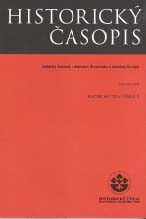Obraz rómskej populácie v Uhorsku na konci 19. storočia
The image of the Romany population in the Kingdom of Hungary at the end of the 19th century
Author(s): Branislav Šprocha, Pavol TišliarSubject(s): Ethnohistory, 19th Century
Published by: Historický ústav SAV
Keywords: Romany; Kingdom of Hungary; Census of Romany in 1893; Age; Sex; Marital status; Literacy; Mother tongue; Religious confession; Source of subsistence; Housing;
Summary/Abstract: Apart from the large ethnic groups, the multi-ethnic Kingdom of Hungary also included several less numerous historic autochthonous and alochthonous ethnic groups. We can describe the initially nomadic Romany group as relatively late arrivals. Thanks to their ethnic difference they were symbolically and often also really excluded from the majority society of the Central European region. As a result of some degree of isolation from the main social developmental currents, the Romany still retained various specific characteristics in late 19th century Hungary, in spite of more or less intensive efforts to achieve their complete integration. One of the important instruments for monitoring the success of individual measures and preparing evidence for their formulation was various types of census. From the point of view of content and methodology, the most important is the census of Romany in Hungary at the end of January 1893. It is a unique source of information on the character of the Romany population in Hungary at the end of the 19th century. The aim of the paper is to consider the background to the census of Romany in 1893, its causes, preparation and implementation, as well as to analyse the main and some specific characteristics of the Romany population of Hungary in 1893 on the basis of the available published data.
Journal: Historický časopis
- Issue Year: 64/2016
- Issue No: 2
- Page Range: 267-297
- Page Count: 31
- Language: Slovak

